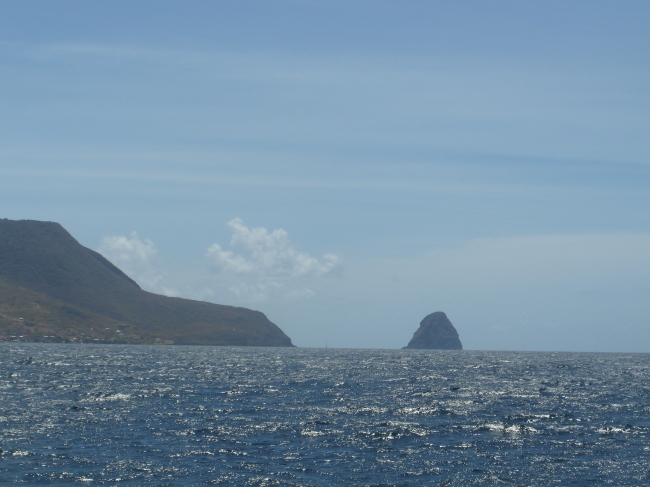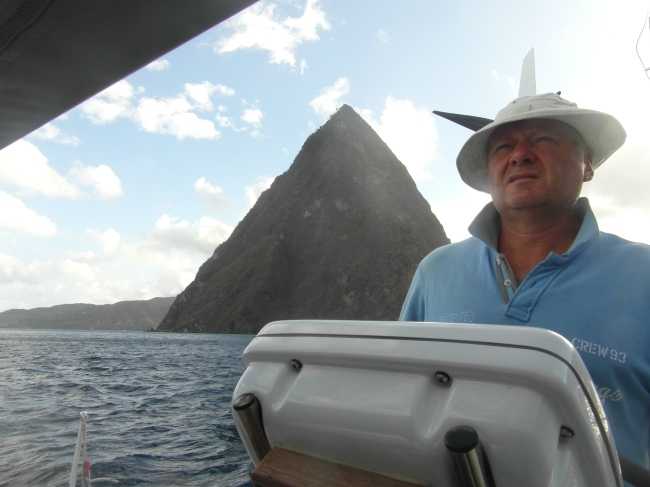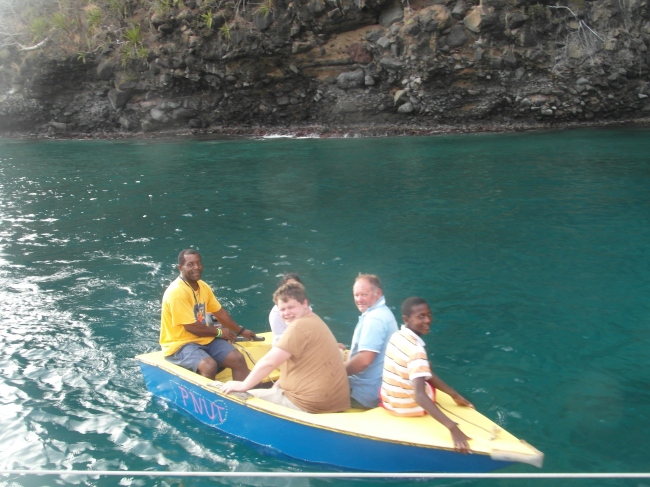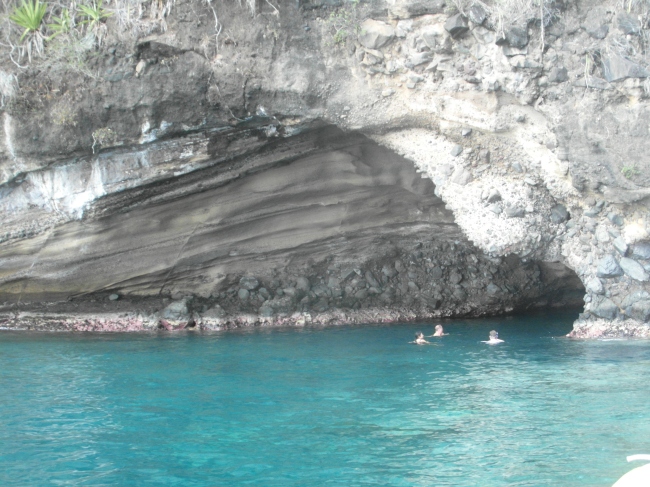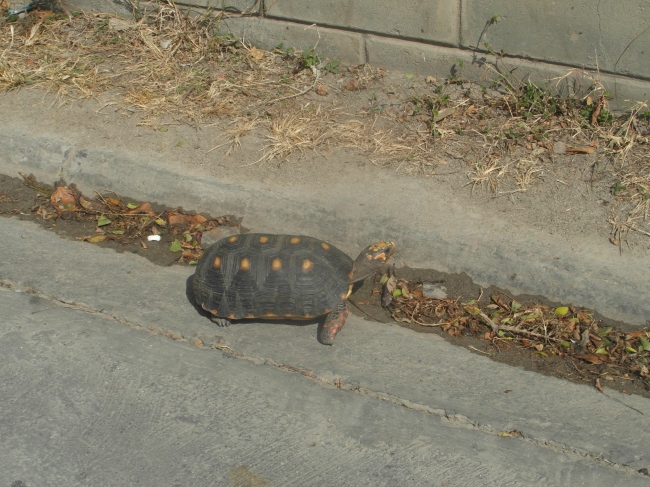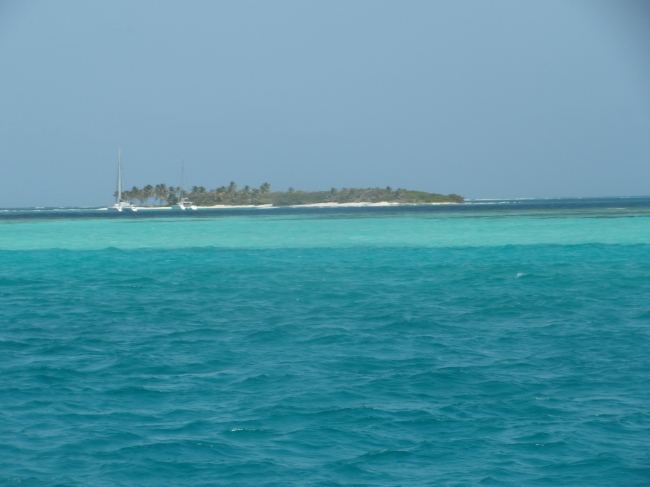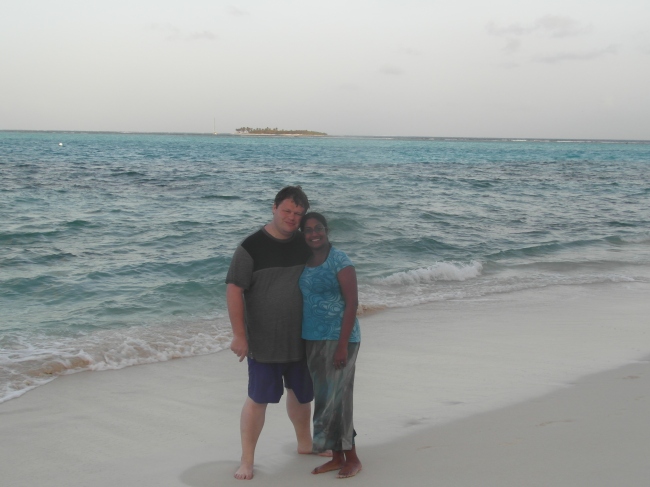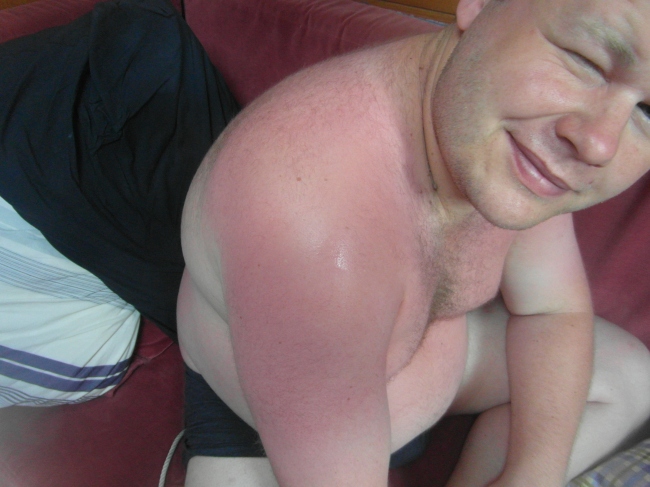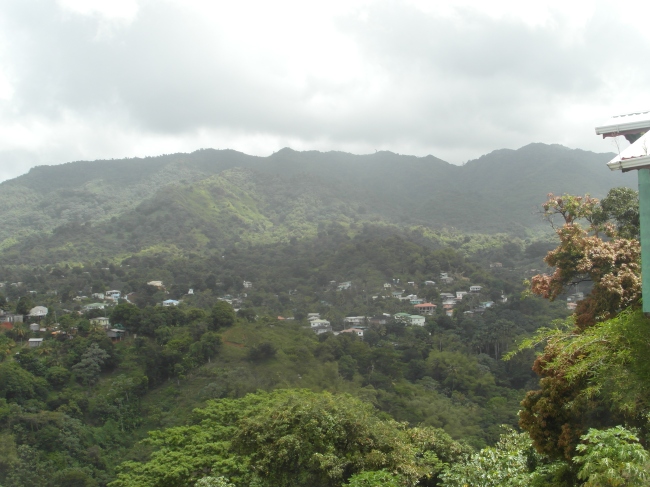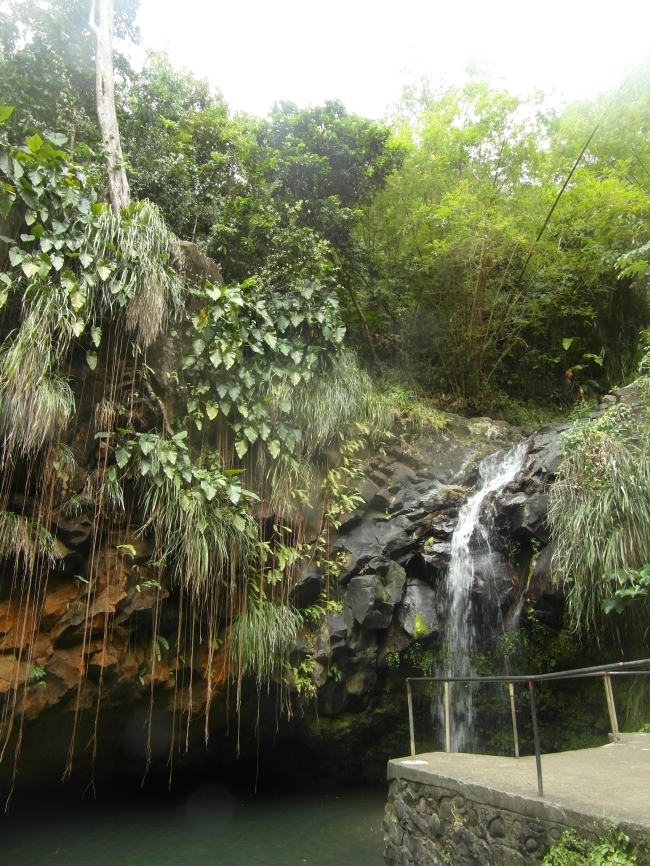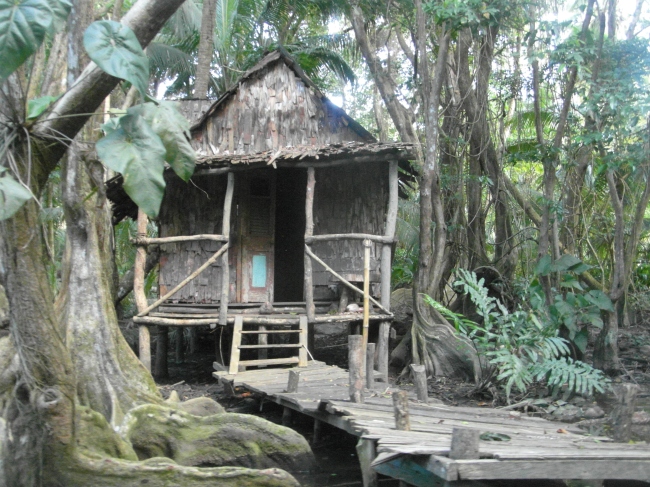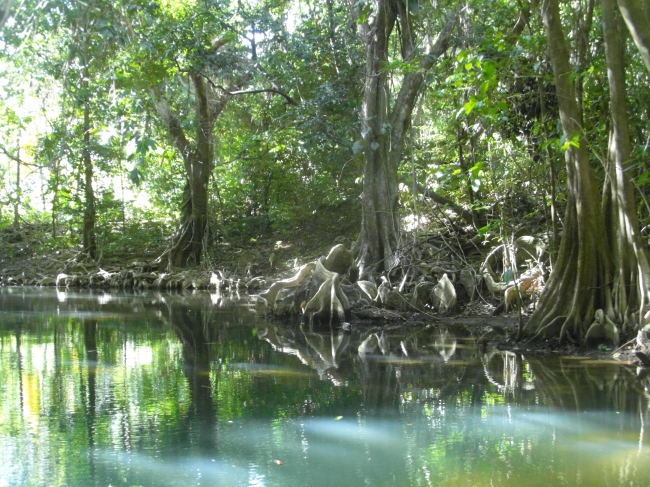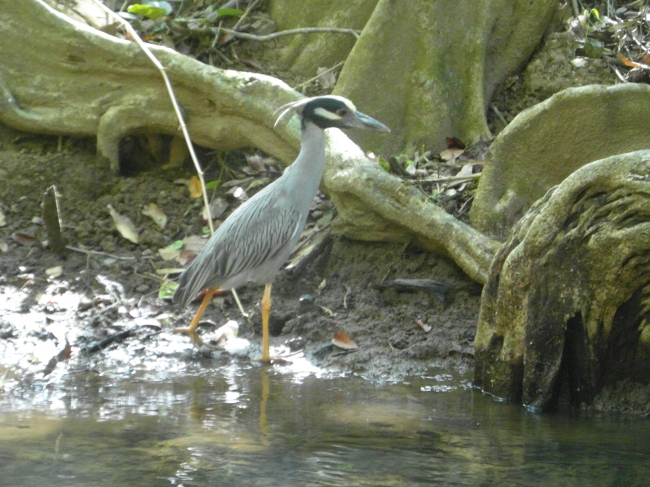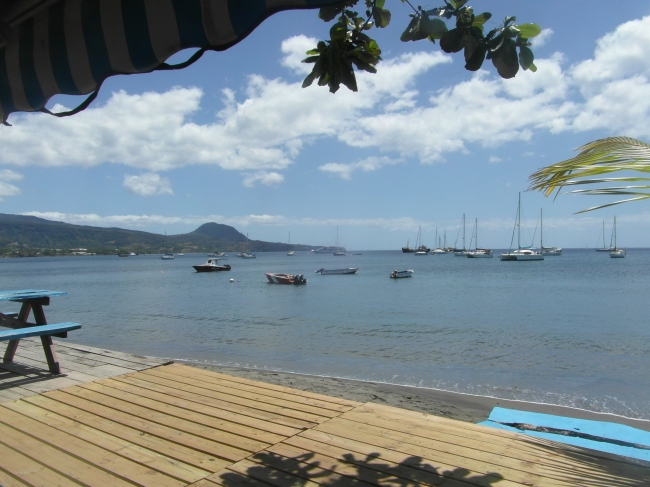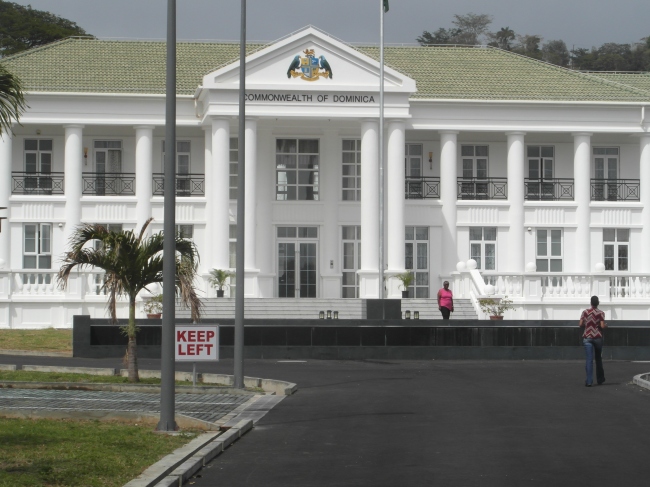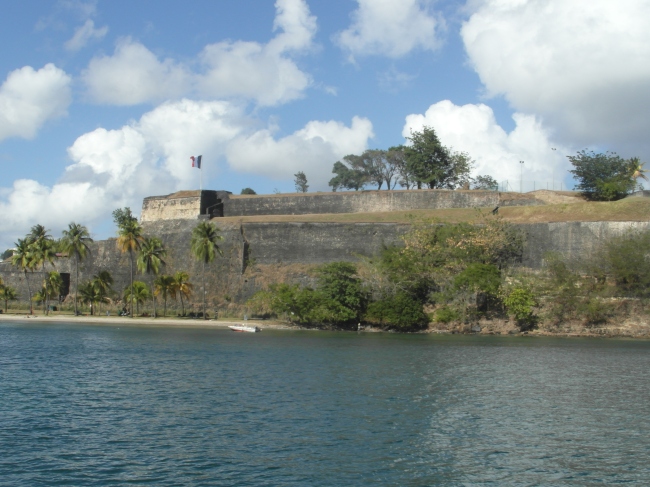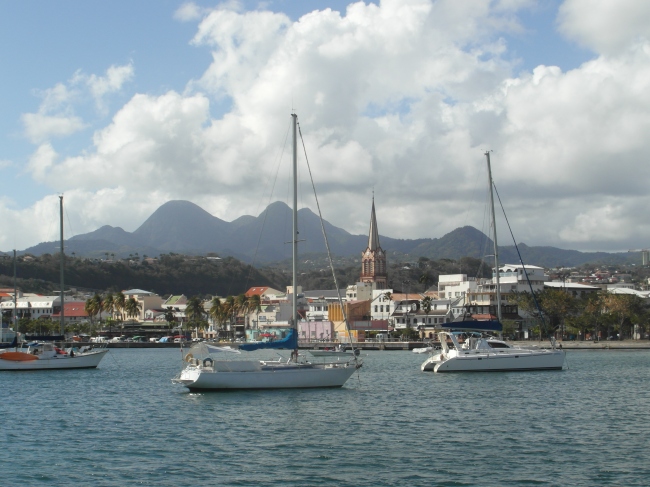We found ourselves leaving Martinique with an apology on our lips that we had nearly skirted past it completely and were certain that our short stop in Fort de France had not availed us of all it had to offer. If possible a return trip was promised at some future point. So much to see, so little time!
Sailing out of the harbour we glimpsed the infamous (from a French perspective) Diamond Rock…or should that be H.M.S. Diamond Rock? Apparently, in 1804 when the British had naval supremacy throughout the Caribbean waters it was felt that Diamond rock would be the perfect place to have a naval ship if one was available to engage the French coming in and out of Fort de France. There being a scarcity of ships someone decided to commission the rock as a ship instead. After 18 months of secretly trudging equipment, cannons and supplies up to the pinnacle of the rock without the French noticing, H.M.S. Diamond Rock raised her ensign and opened fire on the totally unsuspecting French ships leaving and arriving in Martinique. Needless to say, Napoleon was apoplectic – mainly because Martinique was the birthplace of his wife Josephine.
And so it was that we came full circle back to where our Caribbean adventure had begun in December ’13 when we had first arrived in St. Lucia after our epic Atlantic crossing. The nostalgia flooded in (probably a bad choice of verb when at sea!) as we approached her shores again recalling our original approach on that grey day 5 months or so and very nearly 1000 nautical miles earlier. Thus St. Lucia will always have a special place in our hearts – our first experience of the Caribbean on board Resolute. It is sad that it has since been denigrated in the minds of many by the murder of a British yachtie in January. It seems so out of character to the St. Lucia we know and everyone we have met along the way has also commented how implausible it is. We headed into Marigot Bay which is arguably one of the most beautiful bays in the Caribbean and were helped very graciously onto our pre-booked berth and welcomed by the friendly staff. However, we noticed some changes in senior staff and learnt that the Manager of many years had been usurped in favour of a representative of a huge American hotel chain who excitedly regaled us of the mega-plans afoot to “upgrade this place”. Oh dear! What a difference a few months can make. Nonetheless, for the time being at least the marina was still a haven of calm and contentment and the faultlessly attentive staff made our stay there a pleasure once more. Marigot Bay has become in our family history a place from where sons are met….well, at least two of our three that is. We met middle son Simon and his family there back in December and now eldest son Chris and his wife Tanvi were arriving the next day. We drove the now well-trodden route to and from the airport in our rental car, checking as we went the progress that had been made in the restoration of the devastation caused by the massive landslides which tore through the south of the island last Christmas. Impressive road and bridge rebuilding was in evidence; piles of debris had been amassed along the road sides and whole areas cleared ready for replanting one supposed; a massive reconstruction of homes, schools and small businesses was underway. The area seemed to be healing itself on a grand scale which was heartening indeed.
There was no time to hang around. Chris and Tanvi had a mere two weeks with us and in that time we had to cover the large area between St. Lucia and Grenada including St. Vincent and the Grenadines, the Tobago Cays and finally Grenada itself. We needed to step up our rather slovenly pace!
With nostalgia still in the air we headed back down the coast to anchor under the famous Piton peaks where we had spent Christmas with Simon, Liz and Tommy. This time though the weather was fine except for the pesky katabatic winds which I have come to realise are the price one has to pay for parking oneself under any picturesque peak. The boat boys were alongside again helping us find a mooring buoy and offering trips and tours and provisions. Chris and Tanvi being still jet-lagged and weary decided no further island touring was necessary (we had taken in as many of the sites of worth on the way back from the airport). They took instead to enjoying the stunning views and snorkelling in the clear blue waters.
Early next morning we set off for St. Vincent, giving Chris and Tanvi their first (this side of the) Atlantic open water sail. Tanvi is prone to seasickness so we all held our breath rather, but no, with exciting sailing to be had and new skills to be learnt she and Colin did the lion’s share of the sailing whilst Chris and I had plenty of catching up to do. St. Vincent was another one of those islands like Dominica that we half thought of missing off our itinerary because of dodgy security reports in the past, but I hasten to add that we are mightily pleased that we didn’t as it was a gem of a place with none of its Caribbean identity erased. We approached our chosen destination of Wallilabou Bay and of course a boat boy (called Pnut) had dashed out to help us. The main Bay was crowded (it too had found notoriety by being the main filming location for the first Pirates of the Caribbean film) so our boat boy recommended the next Bay called Keartons. He rowed round to help us and picked a buoy for us which was right at the mouth of a cave made famous by the film by Johnny Depp who fortunately had long since departed. On our trusty boat boy’s recommendation we booked dinner that night at a beach-side eatery called The Rock-side Café and we were served a beautifully simple but delicious meal by Rosi (who was originally German) and her husband Orlando. We ate under a canopy in the garden overlooking the harbour and our own boat with the waves lapping on the shore…a perfect introduction to Chris and Tanvi of the magic of Caribbean life. When we left Rosi and Orlando it felt as though we were leaving family – so friendly and hospitable were they both.
By-passing the capital, Kingstown, which had no sheltered anchorage or marina, the next day we sailed down to the very southern tip of St Vincent – Blue Lagoon, the entrance to which is not for the faint-hearted with only a narrow and virtually unmarked channel through the reefs. Needless to say, our doughty Skipper got us in safely and we were escorted to a mooring buoy in the harbour. Chris and Tanvi were keen to go on an escorted trip to the volcano which graced the north of St. Vincent and which boasted a 3 hour hike to the summit. We were somewhat taken aback by this desire as historically Chris has never been a fan of the concept of ‘a walk’. To him it is a four letter word and best avoided unless completely necessary….perhaps Tanvi calling it ‘A hike’ made the difference. Skipper and Gilly-mate declined – surprise, surprise – claiming that they were all volcanoed-out. At 7 the next morning the intrepids set off and returned thoroughly exhausted at about 4 telling tales of woe about their hike over very rough terrain with an escort who had had his mercy-chip removed long ago. The icing on the cake had been when they reached the volcano top, which promised wonderful island-reaching views, the mist and steam completely obscured any view. Skipper and Gilly-mate congratulated each other on a decision well made!
This being Easter weekend we decided not to venture into the capital Freetown by bus as we had planned but to press on instead to Bequia. Knowing that a regatta had been held over the bank holiday weekend in Bequia’s major harbour of Admiralty Bay we avoided it by favouring a huge anchorage on the southern end called Friendship Bay. However, when we arrived it didn’t seem too friendly at all as there was very little space to anchor – most of the available space having been taken up by local boats on mooring buoys. Feeling that time was pressing and with some regret we decided to make it just a lunch-time stop and go on again to the nearby island (all the Grenadines are nearby) of Canouan. En route we passed the famous but private haunt of the royal, rich and famous – Mustique. It is possible to moor there but certain terms and conditions apply to protect the privacy of the inhabitants and our trusty pilot guide advised that the prices in the few bars and restaurants reflected the type of clientele they were trying to attract. Feeling lowly, we sailed past.
Canouan was delightful; a huge sweeping bay alongside a tasteful resort; dusty streets with tortoises roaming free along the road sides, pausing to munch on fallen hibiscus blooms; a fish market where we bought the freshest red snapper for next to nothing and the sweetest pineapples and mangoes to date. If Chris and Tanvi wanted to sample the essence of Caribbean life this was it….albeit with a very decadent resort hotel nearby to provide us with the finer things in life like wifi and rum-punch. We were offered fresh lobster tomorrow from our budding boat boy and self-appointed village guide, Michael. We showed some interest but had to leave quite early the next morning to get to the Tobago Cays. No problem said Michael, I will get up and dive for them early so you can leave by ten. The deal was done. Next morning we saw Michael heading out to the reef and we watched him jumping into the waters over and over again to catch our lobster. Perseverance must have been his middle name and when he eventually proudly returned with his sack of feisty, angry, shellfish he looked exhausted. We gave him the very few Caribbean dollars he had requested for our feast and a few more besides and several cans of cold beer for which he almost pleaded – so well deserved after his exertions. With our haul of lobster languishing in salt water in the kitchen sinks we set sail for the Tobago Cays – supposedly the highlight of any southern Caribbean cruise.
The Tobago Cays are a group of small uninhabited islands, protected from the ocean by a massive horseshoe reef. They look like the quintessential Caribbean islands – all powdery white beach and azure clear waters with palm trees and lush green vegetation. As you might expect they are protected areas and form part of a National Park with designated mooring buoys to protect the coral from anchors. Of course being THE place to go it is crowded….not just a little crowded but share-every-detail-of-your-life-with-your-neighbours crowded. Added to this there are a myriad of boat boys squabbling over who are ‘their’ clients and trying to sell everything possible – from fresh fish to whale teeth necklaces. Not quite the secluded bit of Paradise we had imagined then. However, once there, we were determined to make the best of it so joined the masses on Baradel island to turtle-watch and snorkel (the turtles sensibly seemed to keep a low profile in their ‘designated area’ but could be seen more readily from the dinghy as we went between the islands). Behind the hordes of which we were one, it was truly an awe-inspiring place where one felt the slightly vulnerable freedom of being right out on an ocean limb with nothing but the turquoise waters and the huge skies Keeping a sharp lookout we managed to swap our buoy in the middle of the pack for one on the periphery immediately it became vacant and enjoyed the relative solitude there for a further day – enjoying especially the near desertion of our desert island idyll (well, sharing it only with a French family playing boules and a German couple body-boarding and numerous snorkelers shouting to each other when they saw something extraordinary….).
Slightly disillusioned we carefully reef-hopped out of the Cays and on to Salt Whistle Bay, on the island of Mayreux – only a couple of hours sail away. This Bay has a sweeping crescent of beach and a lively atmosphere with a beach bar, a small and subtle resort and multiple sellers of sarongs and T shirts looking like lines of colourful washing from afar. A surfeit of bare back snorkelling in the Cays had left Christopher looking like a lobster so he for several days kept himself below decks and like Dracula only ventured out in the evenings….such a shame with Mayreux to explore. Needless to say there were plenty of jokes about how a doctor should show more awareness to the dangers of too much sun! Naturally, Tanvi definitely had the last laugh.
- This time to Union Island in order to quickly site-see and clear out of the Grenadines. Christopher was still literally laid low, nursing his blisters (ouch) and was unable to join our hasty exploration. Skipper was quite pleased to leave somebody on the boat in any case as the buoy to which we had been escorted gave us very little swing or drag room in the overcrowded, busy Clifton harbour. Our glimpse at Union though made us feel again that we were not doing it justice. The village of Clifton was very twee – shops, restaurants and little colourful market huts selling fresh fruit and vegetables clustered round a little village green. We learnt that the little (only about 25 miles square – but with high peaks) island had been mainly populated by Scots when it was first inhabited in the 18th and 19th centuries and there was certainly an air of secluded highland village about the place…albeit with trailing bougainvillea everywhere and warm clear blue seas lapping the shoreline. We were able to take back some lunch to our wounded crew-member. The take-away of choice throughout the Caribbean is roti – wraps of curried and spiced chicken or beef…but the most popular filling is lambi which is the local word for conch. When in a dash they are the perfect hearty snack. And we were in a dash. Having done some shopping and completed the clearing out formalities we left Clifton basin and headed the few miles east to Petite Martinique. Our particular yen to visit the tiny island of Petite Martinique (no relation to the grand French isle already mentioned), had its basis in the great reviews we had read for a restaurant there called The Palm Beach. Helpfully this restaurant also provided mooring buoys for its customers and a water taxi to its tables. Perfect. Petite Martinique (PM to its friends) is completely unspoilt and relies on the authentic trades of wooden ship-building and fishing for its survival – topped up in the high season with us tourists too. We radio-ed the restaurant, and sure enough our water taxi came to collect us at the appointed hour and we were shown to a table over-looking the beach in the secluded garden under a shady canopy. In this spectacular but simple setting we ate spectacular but simple food which was absolutely delicious. Callalou (a local sweet tasting leaf something like spinach) soup, followed by the inevitable lobster and fresh seafood dishes all mopped up with home-made bread and puds to die for. No doubt lobsters everywhere in the Caribbean were breathing a huge sigh of relief at this juncture as their comparative freedom season was just about to begin for them on 1st May……the alternative view of course being the catching season was just ending….so at the tail end of April, lobster was everywhere whilst the going was just about good. Replete with our excellent meal we were taken back to our boat ready for our final Atlantic sail with Chris and Tanvi to Grenada.
Just as you are thinking we have nearly finished this lengthy tome, here we are in Glorious Grenada which deserves so much more than to be glossed over. It is a very special island – sophisticated and cosmopolitan but without having lost its Caribbean flavour and identity in the least. To get to the Grenadian Yacht Club in the capital, St. Georges where we had reserved a berth, required a long day sail, but with Chris being fully recovered, we all enjoyed and relished the journey. Grenada is a relatively large volcanic island which is called ‘The Spice Island’ due to the rich agricultural lands it is blessed with due to the rich volcanic soil. Nutmeg, cinnamon, mace along with coconuts and bananas form the mainstay of the economy alongside the thriving tourist industry of course. With Chris and Tanvi only sadly having one last day to see Grenada we took up Pete the Taxi’s offer of a trip to Customs to clear-in followed by a whistle-stop island tour for a bargain price. We covered such a lot in one day: winding through the bustling streets of St Georges on market day with Pete tooting his horn at everyone he knew; swimming in the beautiful Annandale waterfalls after a short hike (or is that walk) through the exotic rain forest trail to get there; driving up and up and up through the dense forest to the lofty volcanic crater at Grand Etang with spectacular views from a wooden viewing station seemingly at the top of the world – looking for the shy little monkeys which occasionally make an appearance there – but to no avail. The Rivers rum distillery was incredible as it still used exactly the same methods to distil and bottle their rum as they had since the 1800’s. Our tour guide was very entertaining and we were able to partake of the resulting grog (some of which is 80% proof!). Our last port of call was to the Belmont Plantation Estate where we saw how it makes its famous organic chocolate which is found throughout the southern Caribbean. Never having much considered how cocoa was grown and the resulting chocolate produced it was a fascinating tour and of course the tasting afterwards was divine! The history of the estate was also very interesting as the plantation had been taken over by an Indian immigrant family in the early 1900’s who still own and run it along with other plantations on the island and have turned it into a huge commercial success. Pete then took us back along the Atlantic coast road, pointing out things of interest along the way, especially the southern bays which housed beautiful estates of stunning properties overlooking many small marinas and anchorages. A mental note was made of these as Skipper and Gilly-mate intended to stay in Glorious Grenada after Chris and Tanvi had left them – not having to be in Trinidad until the end of May, a welcome return back to the slovenly pace of old.

